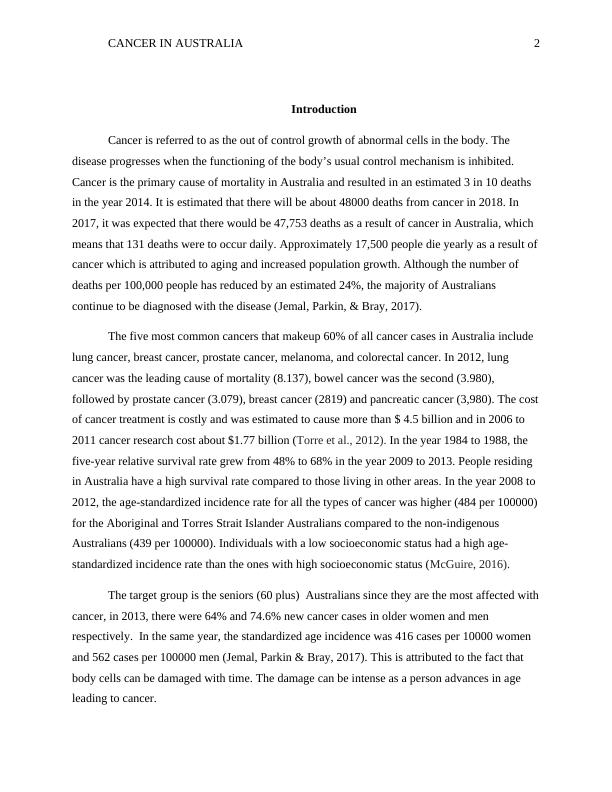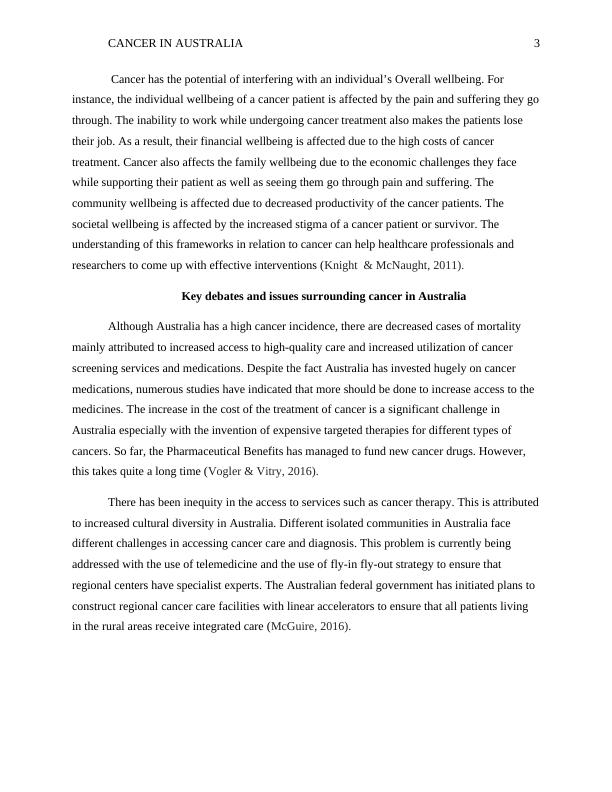Cancer in Australia: Mortality, Common Cancers, Risk Factors, and Health Promotion Strategies
Added on 2023-06-04
8 Pages2459 Words235 Views
Running head: CANCER IN AUSTRALIA 1
Cancer in Australia
Students Name
Institutional Affiliation
Cancer in Australia
Students Name
Institutional Affiliation

CANCER IN AUSTRALIA 2
Introduction
Cancer is referred to as the out of control growth of abnormal cells in the body. The
disease progresses when the functioning of the body’s usual control mechanism is inhibited.
Cancer is the primary cause of mortality in Australia and resulted in an estimated 3 in 10 deaths
in the year 2014. It is estimated that there will be about 48000 deaths from cancer in 2018. In
2017, it was expected that there would be 47,753 deaths as a result of cancer in Australia, which
means that 131 deaths were to occur daily. Approximately 17,500 people die yearly as a result of
cancer which is attributed to aging and increased population growth. Although the number of
deaths per 100,000 people has reduced by an estimated 24%, the majority of Australians
continue to be diagnosed with the disease (Jemal, Parkin, & Bray, 2017).
The five most common cancers that makeup 60% of all cancer cases in Australia include
lung cancer, breast cancer, prostate cancer, melanoma, and colorectal cancer. In 2012, lung
cancer was the leading cause of mortality (8.137), bowel cancer was the second (3.980),
followed by prostate cancer (3.079), breast cancer (2819) and pancreatic cancer (3,980). The cost
of cancer treatment is costly and was estimated to cause more than $ 4.5 billion and in 2006 to
2011 cancer research cost about $1.77 billion (Torre et al., 2012). In the year 1984 to 1988, the
five-year relative survival rate grew from 48% to 68% in the year 2009 to 2013. People residing
in Australia have a high survival rate compared to those living in other areas. In the year 2008 to
2012, the age-standardized incidence rate for all the types of cancer was higher (484 per 100000)
for the Aboriginal and Torres Strait Islander Australians compared to the non-indigenous
Australians (439 per 100000). Individuals with a low socioeconomic status had a high age-
standardized incidence rate than the ones with high socioeconomic status (McGuire, 2016).
The target group is the seniors (60 plus) Australians since they are the most affected with
cancer, in 2013, there were 64% and 74.6% new cancer cases in older women and men
respectively. In the same year, the standardized age incidence was 416 cases per 10000 women
and 562 cases per 100000 men (Jemal, Parkin & Bray, 2017). This is attributed to the fact that
body cells can be damaged with time. The damage can be intense as a person advances in age
leading to cancer.
Introduction
Cancer is referred to as the out of control growth of abnormal cells in the body. The
disease progresses when the functioning of the body’s usual control mechanism is inhibited.
Cancer is the primary cause of mortality in Australia and resulted in an estimated 3 in 10 deaths
in the year 2014. It is estimated that there will be about 48000 deaths from cancer in 2018. In
2017, it was expected that there would be 47,753 deaths as a result of cancer in Australia, which
means that 131 deaths were to occur daily. Approximately 17,500 people die yearly as a result of
cancer which is attributed to aging and increased population growth. Although the number of
deaths per 100,000 people has reduced by an estimated 24%, the majority of Australians
continue to be diagnosed with the disease (Jemal, Parkin, & Bray, 2017).
The five most common cancers that makeup 60% of all cancer cases in Australia include
lung cancer, breast cancer, prostate cancer, melanoma, and colorectal cancer. In 2012, lung
cancer was the leading cause of mortality (8.137), bowel cancer was the second (3.980),
followed by prostate cancer (3.079), breast cancer (2819) and pancreatic cancer (3,980). The cost
of cancer treatment is costly and was estimated to cause more than $ 4.5 billion and in 2006 to
2011 cancer research cost about $1.77 billion (Torre et al., 2012). In the year 1984 to 1988, the
five-year relative survival rate grew from 48% to 68% in the year 2009 to 2013. People residing
in Australia have a high survival rate compared to those living in other areas. In the year 2008 to
2012, the age-standardized incidence rate for all the types of cancer was higher (484 per 100000)
for the Aboriginal and Torres Strait Islander Australians compared to the non-indigenous
Australians (439 per 100000). Individuals with a low socioeconomic status had a high age-
standardized incidence rate than the ones with high socioeconomic status (McGuire, 2016).
The target group is the seniors (60 plus) Australians since they are the most affected with
cancer, in 2013, there were 64% and 74.6% new cancer cases in older women and men
respectively. In the same year, the standardized age incidence was 416 cases per 10000 women
and 562 cases per 100000 men (Jemal, Parkin & Bray, 2017). This is attributed to the fact that
body cells can be damaged with time. The damage can be intense as a person advances in age
leading to cancer.

CANCER IN AUSTRALIA 3
Cancer has the potential of interfering with an individual’s Overall wellbeing. For
instance, the individual wellbeing of a cancer patient is affected by the pain and suffering they go
through. The inability to work while undergoing cancer treatment also makes the patients lose
their job. As a result, their financial wellbeing is affected due to the high costs of cancer
treatment. Cancer also affects the family wellbeing due to the economic challenges they face
while supporting their patient as well as seeing them go through pain and suffering. The
community wellbeing is affected due to decreased productivity of the cancer patients. The
societal wellbeing is affected by the increased stigma of a cancer patient or survivor. The
understanding of this frameworks in relation to cancer can help healthcare professionals and
researchers to come up with effective interventions (Knight & McNaught, 2011).
Key debates and issues surrounding cancer in Australia
Although Australia has a high cancer incidence, there are decreased cases of mortality
mainly attributed to increased access to high-quality care and increased utilization of cancer
screening services and medications. Despite the fact Australia has invested hugely on cancer
medications, numerous studies have indicated that more should be done to increase access to the
medicines. The increase in the cost of the treatment of cancer is a significant challenge in
Australia especially with the invention of expensive targeted therapies for different types of
cancers. So far, the Pharmaceutical Benefits has managed to fund new cancer drugs. However,
this takes quite a long time (Vogler & Vitry, 2016).
There has been inequity in the access to services such as cancer therapy. This is attributed
to increased cultural diversity in Australia. Different isolated communities in Australia face
different challenges in accessing cancer care and diagnosis. This problem is currently being
addressed with the use of telemedicine and the use of fly-in fly-out strategy to ensure that
regional centers have specialist experts. The Australian federal government has initiated plans to
construct regional cancer care facilities with linear accelerators to ensure that all patients living
in the rural areas receive integrated care (McGuire, 2016).
Cancer has the potential of interfering with an individual’s Overall wellbeing. For
instance, the individual wellbeing of a cancer patient is affected by the pain and suffering they go
through. The inability to work while undergoing cancer treatment also makes the patients lose
their job. As a result, their financial wellbeing is affected due to the high costs of cancer
treatment. Cancer also affects the family wellbeing due to the economic challenges they face
while supporting their patient as well as seeing them go through pain and suffering. The
community wellbeing is affected due to decreased productivity of the cancer patients. The
societal wellbeing is affected by the increased stigma of a cancer patient or survivor. The
understanding of this frameworks in relation to cancer can help healthcare professionals and
researchers to come up with effective interventions (Knight & McNaught, 2011).
Key debates and issues surrounding cancer in Australia
Although Australia has a high cancer incidence, there are decreased cases of mortality
mainly attributed to increased access to high-quality care and increased utilization of cancer
screening services and medications. Despite the fact Australia has invested hugely on cancer
medications, numerous studies have indicated that more should be done to increase access to the
medicines. The increase in the cost of the treatment of cancer is a significant challenge in
Australia especially with the invention of expensive targeted therapies for different types of
cancers. So far, the Pharmaceutical Benefits has managed to fund new cancer drugs. However,
this takes quite a long time (Vogler & Vitry, 2016).
There has been inequity in the access to services such as cancer therapy. This is attributed
to increased cultural diversity in Australia. Different isolated communities in Australia face
different challenges in accessing cancer care and diagnosis. This problem is currently being
addressed with the use of telemedicine and the use of fly-in fly-out strategy to ensure that
regional centers have specialist experts. The Australian federal government has initiated plans to
construct regional cancer care facilities with linear accelerators to ensure that all patients living
in the rural areas receive integrated care (McGuire, 2016).

End of preview
Want to access all the pages? Upload your documents or become a member.
Related Documents
Health Disparity | Cancer Assignmentlg...
|6
|1281
|16
A Critique of the Literature on Lung Cancer in Australialg...
|8
|2602
|185
Health Promotion for Breast Cancer | Reportlg...
|12
|3319
|144
The Emergence of Translational Epidemiologylg...
|11
|3409
|260
Breast Cancer: Preventive Measures and Drug Treatment Optionslg...
|10
|1178
|61
Health Promotion Program for Breast Cancer in Womenlg...
|23
|5322
|495
